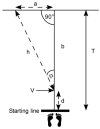Walking speed and vestibular disorders in a path integration task
- PMID: 21131202
- PMCID: PMC3042484
- DOI: 10.1016/j.gaitpost.2010.11.007
Walking speed and vestibular disorders in a path integration task
Abstract
The goal of this study was to determine if parameters of gait are related to the path integration deficits in some people with vestibular disorders. We tested normals, and two groups of vestibularly impaired people, with unilateral benign paroxysmal positional vertigo and with unilateral weakness. Each group had 20 subjects. They walked straight ahead for 7.62 m, with eyes open or closed, to the beat of a metronome at 60 beats/min, 120 beats/min and 176 beats/min. When adjusted for age and sex, normals veered significantly less and walked significantly further before veering than the unilateral weakness group; all groups veered significantly less at 120 beats/min than the slower or faster cadences. Older patients walked slightly but significantly slower than younger patients at the faster speeds. Step length did not differ among diagnostic groups. These data confirm the involvement of vestibular function in path integration, suggest a differentiation by type of vestibular impairment, and suggest some differences by cadence.
Copyright © 2010 Elsevier B.V. All rights reserved.
Conflict of interest statement
Neither author has a conflict of interest.
Figures

Similar articles
-
Vestibular disorders and dual task performance: impairment when walking a straight path.J Vestib Res. 2011;21(3):167-74. doi: 10.3233/VES-2011-0415. J Vestib Res. 2011. PMID: 21558642 Free PMC article.
-
Vestibular disorders and impaired path integration along a linear trajectory.J Vestib Res. 2000;10(1):7-15. J Vestib Res. 2000. PMID: 10798829
-
Linear path integration deficits in patients with abnormal vestibular afference.Seeing Perceiving. 2012;25(2):155-78. doi: 10.1163/187847612X629928. Seeing Perceiving. 2012. PMID: 22726251 Free PMC article.
-
Vestibular rehabilitation of patients with vestibular hypofunction or with benign paroxysmal positional vertigo.Curr Opin Neurol. 2000 Feb;13(1):39-43. doi: 10.1097/00019052-200002000-00008. Curr Opin Neurol. 2000. PMID: 10719648 Review.
-
Vision and vertigo: some visual aspects of vestibular disorders.J Neurol. 2004 Apr;251(4):381-7. doi: 10.1007/s00415-004-0410-7. J Neurol. 2004. PMID: 15083281 Review.
Cited by
-
Vestibular activity and cognitive development in children: perspectives.Front Integr Neurosci. 2013 Dec 11;7:92. doi: 10.3389/fnint.2013.00092. eCollection 2013. Front Integr Neurosci. 2013. PMID: 24376403 Free PMC article.
-
Executive functions in patients with bilateral and unilateral peripheral vestibular dysfunction.J Neurol. 2024 Jun;271(6):3291-3308. doi: 10.1007/s00415-024-12267-7. Epub 2024 Mar 11. J Neurol. 2024. PMID: 38466421 Free PMC article.
-
Effectiveness of the aquatic physical therapy exercises to improve balance, gait, quality of life and reduce fall-related outcomes in healthy community-dwelling older adults: A systematic review and meta-analysis.PLoS One. 2023 Sep 8;18(9):e0291193. doi: 10.1371/journal.pone.0291193. eCollection 2023. PLoS One. 2023. PMID: 37683025 Free PMC article.
-
A quantitative analysis of gait patterns in vestibular neuritis patients using gyroscope sensor and a continuous walking protocol.J Neuroeng Rehabil. 2014 Apr 11;11:58. doi: 10.1186/1743-0003-11-58. J Neuroeng Rehabil. 2014. PMID: 24725764 Free PMC article.
-
Gait disorientation as a proxy for impaired spatial navigation: Associations between the Gait Disorientation Test and vestibular-mediated functions.Neuropsychologia. 2025 Jun 19;217:109212. doi: 10.1016/j.neuropsychologia.2025.109212. Online ahead of print. Neuropsychologia. 2025. PMID: 40543566
References
-
- Mittelstaedt H, Mittelstaedt M-L. Homing by path integration. In: Papi P, Wallraff HG, editors. Avian Navigation. Berlin Heidelberg: Springer-Verlag; 1982. pp. 290–7.
-
- Barlow JS. Inertial navigation as a basis for animal navigation. J Theor Biol. 1964;6:76–117. - PubMed
-
- Mayne R. A systems concept of the vestibular organs. In: Kornhuber HH, editor. Handbook of Sensory Physiology. Berlin: Springer Verlag; 1974. pp. 493–580.
-
- Miller S, Potegal M, Abraham L. Vestibular involvement in a passive transport and return task. Physiol Psychol. 1983;11:1–10.
-
- Cohen HS. Vestibular disorders and impaired path integration along a linear trajectory. J Vestib Res. 2000;10:7–15. - PubMed
Publication types
MeSH terms
Grants and funding
LinkOut - more resources
Full Text Sources
Other Literature Sources

